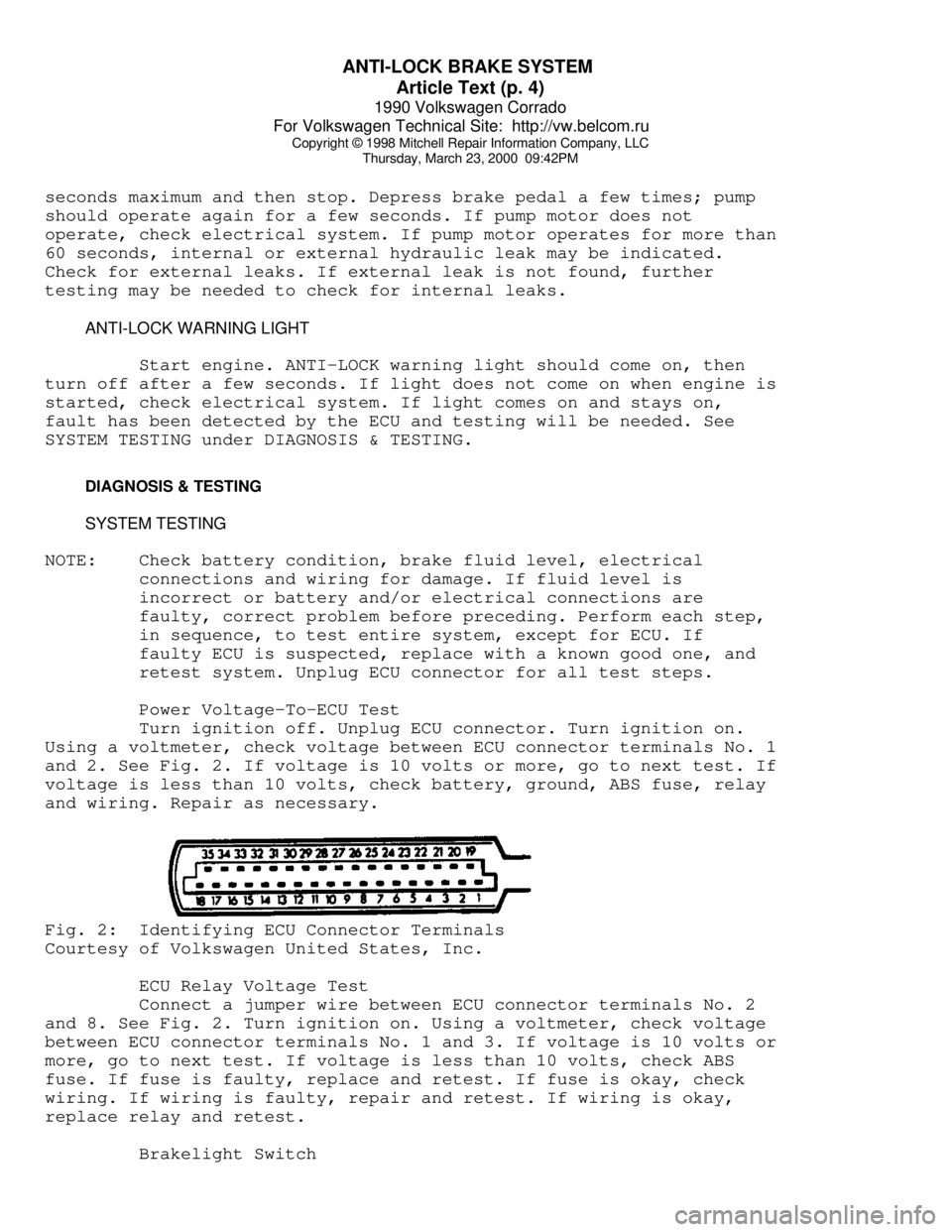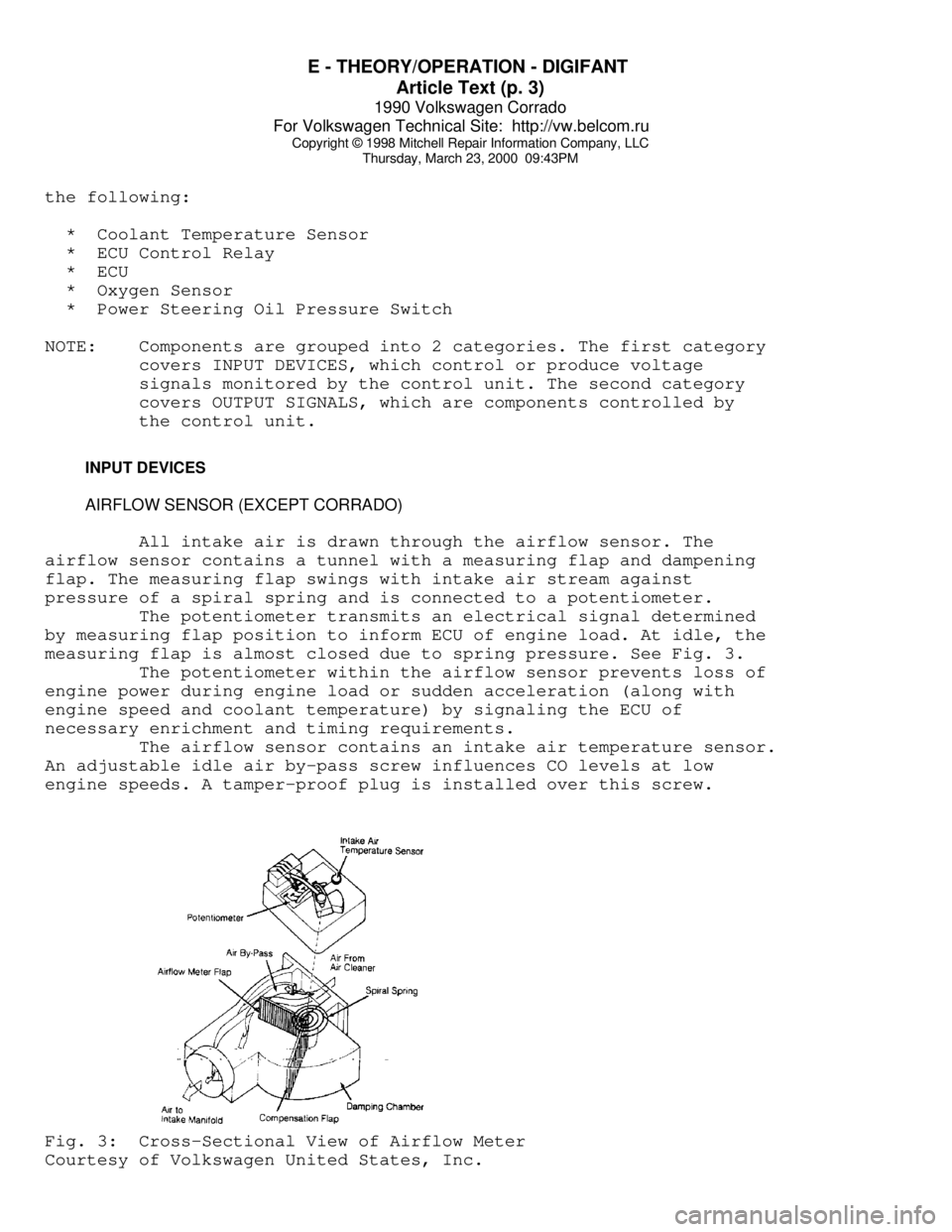1990 VOLKSWAGEN CORRADO relay
[x] Cancel search: relayPage 399 of 906

ABBREVIATIONS
Article Text (p. 10)
1990 Volkswagen Corrado
For Volkswagen Technical Site: http://vw.belcom.ru
Copyright © 1998 Mitchell Repair Information Company, LLC
Thursday, March 23, 2000 09:42PM
"Q" ABBREVIATION TABLE
"Q" ABBREVIATION TABLEÚÄÄÄÄÄÄÄÄÄÄÄÄÄÄÄÄÄÂÄÄÄÄÄÄÄÄÄÄÄÄÄÄÄÄÄÄÄÄÄÄÄÄÄÄÄÄÄÄÄÄÄÄÄÄÄÄÄÄÄÄÄÄÄÄÄÄÄÄ¿
³ABBREVIATION
³DEFINITION ³
ÃÄÄÄÄÄÄÄÄÄÄÄÄÄÄÄÄÄÅÄÄÄÄÄÄÄÄÄÄÄÄÄÄÄÄÄÄÄÄÄÄÄÄÄÄÄÄÄÄÄÄÄÄÄÄÄÄÄÄÄÄÄÄÄÄÄÄÄÄ´
³Qts.
³Quarts ³
ÀÄÄÄÄÄÄÄÄÄÄÄÄÄÄÄÄÄÁÄÄÄÄÄÄÄÄÄÄÄÄÄÄÄÄÄÄÄÄÄÄÄÄÄÄÄÄÄÄÄÄÄÄÄÄÄÄÄÄÄÄÄÄÄÄÄÄÄÄÙ "R" ABBREVIATION TABLE
"R" ABBREVIATION TABLE
ÚÄÄÄÄÄÄÄÄÄÄÄÄÄÄÄÄÄÂÄÄÄÄÄÄÄÄÄÄÄÄÄÄÄÄÄÄÄÄÄÄÄÄÄÄÄÄÄÄÄÄÄÄÄÄÄÄÄÄÄÄÄÄÄÄÄÄÄÄ¿
³ABBREVIATION
³DEFINITION ³
ÃÄÄÄÄÄÄÄÄÄÄÄÄÄÄÄÄÄÅÄÄÄÄÄÄÄÄÄÄÄÄÄÄÄÄÄÄÄÄÄÄÄÄÄÄÄÄÄÄÄÄÄÄÄÄÄÄÄÄÄÄÄÄÄÄÄÄÄÄ´
³RABS
³Rear Anti-Lock Brake System ³
³RAC
³Remote Accessory Control ³
³RAM
³Random Access Memory ³
³RAP
³Retained Accessory Power ³
³RECIRC
³Recirculation ³
³RED
³Red ³
³RH
³Right Hand ³
³ROM
³Read Only Memory ³
³RPM
³Revolutions Per Minute ³
³RVB
³Rear Vacuum Break ³
³RWAL
³Rear Wheel Anti-Lock Brake ³
³RWD
³Rear Wheel Drive ³
³Recirc.
³Recirculate or Recirculation ³
³Reg.
³Regulator ³
³Rly.
³Relay ³
ÀÄÄÄÄÄÄÄÄÄÄÄÄÄÄÄÄÄÁÄÄÄÄÄÄÄÄÄÄÄÄÄÄÄÄÄÄÄÄÄÄÄÄÄÄÄÄÄÄÄÄÄÄÄÄÄÄÄÄÄÄÄÄÄÄÄÄÄÄÙ "S" ABBREVIATION TABLE
"S" ABBREVIATION TABLE
ÚÄÄÄÄÄÄÄÄÄÄÄÄÄÄÄÄÄÂÄÄÄÄÄÄÄÄÄÄÄÄÄÄÄÄÄÄÄÄÄÄÄÄÄÄÄÄÄÄÄÄÄÄÄÄÄÄÄÄÄÄÄÄÄÄÄÄÄÄ¿
³ABBREVIATION
³DEFINITION ³
ÃÄÄÄÄÄÄÄÄÄÄÄÄÄÄÄÄÄÅÄÄÄÄÄÄÄÄÄÄÄÄÄÄÄÄÄÄÄÄÄÄÄÄÄÄÄÄÄÄÄÄÄÄÄÄÄÄÄÄÄÄÄÄÄÄÄÄÄÄ´
³SBC
³Single Bed Converter ³
³SBEC
³Single Board Engine Controller ³
³SC
³Super Charged ³
³SCC
³Spark Control Computer ³
³SCS
³Air Suction Control Solenoid ³
³SDM
³Supplemental Restraint System Diagnostic Module ³
³SDU
³SRS Diagnostic Unit ³
³SEN
³Sensor ³
³SES
³Service Engine Soon ³
³SFI
³Sequential (Port) Fuel Injection ³
³SIG RTN
³Signal Return circuit ³
³SIL
³Shift Indicator Light ³
Page 409 of 906

ANTI-LOCK BRAKE SYSTEM
Article Text
1990 Volkswagen Corrado
For Volkswagen Technical Site: http://vw.belcom.ru
Copyright © 1998 Mitchell Repair Information Company, LLC
Thursday, March 23, 2000 09:42PM
ARTICLE BEGINNING
1990-92 BRAKES
Volkswagen Anti-Lock Brake System
Corrado, Jetta, Passat
DESCRIPTION
All models use a Teves Anti-Lock Brake System (ABS). See
Fig. 1. This system reduces the chance of wheel lock-up during heavy
braking. The system consists of 4 wheel speed sensors, Electronic
Control Unit (ECU), hydraulic modulator/pump and solenoid valves,
ANTI-LOCK warning light and BRAKE warning light. There are 2 relays
located at fuse/relay panel, to protect the hydraulic modulator and
ECU.
NOTE: For more information on brake system, see appropriate BRAKE
SYSTEM article.
OPERATION
When pressure is applied to brake pedal, the ECU monitors
input signals from each wheel speed sensor. If ECU measures a rate of
reduction greater than what is programmed in ECU, the ECU will output
a signal to appropriate solenoid valve. Each solenoid valve allows
hydraulic pressure to increase or decrease to the appropriate wheel
cylinder.
If a system failure occurs, the ANTI-LOCK warning light,
located on instrument panel, will come on. System will be deactivated,
but conventional brake system will still operate. If brake fluid level
drops too low, BRAKE warning light, located on instrument panel, will
come on.
ANTI-LOCK BRAKE SAFETY PRECAUTIONS
* NEVER open a bleeder valve or loosen a hydraulic line while
ABS is pressurized,
* NEVER disconnect or reconnect any electrical connectors while
ignition is on. Damage to ABS control unit may result.
* Only use specially designed brake hoses/lines on ABS equipped
vehicles.
* DO NOT tap on speed sensor components (sensor, sensor rings).
Speed rings must be pressed, NOT hammered into hubs. Striking
these components can cause demagnetization or a loss of
polarization, affecting the accuracy of the speed signal
returning to the ABS control unit.
* DO NOT mix tire sizes. Increasing the width, as long as tires
remain close to the original diameter, is acceptable. Rolling
diameter must be identical for all 4 tires (and spare tire
also). Some manufacturers recommend tires of the same brand,
Page 412 of 906

ANTI-LOCK BRAKE SYSTEM
Article Text (p. 4)
1990 Volkswagen Corrado
For Volkswagen Technical Site: http://vw.belcom.ru
Copyright © 1998 Mitchell Repair Information Company, LLC
Thursday, March 23, 2000 09:42PM
seconds maximum and then stop. Depress brake pedal a few times; pump
should operate again for a few seconds. If pump motor does not
operate, check electrical system. If pump motor operates for more than
60 seconds, internal or external hydraulic leak may be indicated.
Check for external leaks. If external leak is not found, further
testing may be needed to check for internal leaks.
ANTI-LOCK WARNING LIGHT
Start engine. ANTI-LOCK warning light should come on, then
turn off after a few seconds. If light does not come on when engine is
started, check electrical system. If light comes on and stays on,
fault has been detected by the ECU and testing will be needed. See
SYSTEM TESTING under DIAGNOSIS & TESTING.
DIAGNOSIS & TESTING
SYSTEM TESTING
NOTE: Check battery condition, brake fluid level, electrical
connections and wiring for damage. If fluid level is
incorrect or battery and/or electrical connections are
faulty, correct problem before preceding. Perform each step,
in sequence, to test entire system, except for ECU. If
faulty ECU is suspected, replace with a known good one, and
retest system. Unplug ECU connector for all test steps.
Power Voltage-To-ECU Test
Turn ignition off. Unplug ECU connector. Turn ignition on.
Using a voltmeter, check voltage between ECU connector terminals No. 1
and 2. See Fig. 2. If voltage is 10 volts or more, go to next test. If
voltage is less than 10 volts, check battery, ground, ABS fuse, relay
and wiring. Repair as necessary.Fig. 2: Identifying ECU Connector Terminals
Courtesy of Volkswagen United States, Inc.
ECU Relay Voltage Test
Connect a jumper wire between ECU connector terminals No. 2
and 8. See Fig. 2. Turn ignition on. Using a voltmeter, check voltage
between ECU connector terminals No. 1 and 3. If voltage is 10 volts or
more, go to next test. If voltage is less than 10 volts, check ABS
fuse. If fuse is faulty, replace and retest. If fuse is okay, check
wiring. If wiring is faulty, repair and retest. If wiring is okay,
replace relay and retest.
Brakelight Switch
Page 413 of 906

ANTI-LOCK BRAKE SYSTEM
Article Text (p. 5)
1990 Volkswagen Corrado
For Volkswagen Technical Site: http://vw.belcom.ru
Copyright © 1998 Mitchell Repair Information Company, LLC
Thursday, March 23, 2000 09:42PM
Turn ignition on. Apply brakes. Check for 12 volts between
terminals No. 12 and 1. If 12 volts are present, brakelight switch is
okay. If 12 volts are not present, check fuse, brakelight switch and
Black/Red wire from brakelight switch to ECU.
Hydraulic Modulator/Pump Relay Voltage Test
1) Turn ignition off. Unplug hydraulic modulator/pump
connector. Depress brake pedal 25 times. Turn ignition on. Using a
voltmeter, measure voltage between ECU connector terminals No. 1 and
32. See Fig. 2. If voltage is 10 volts or more, go to RIGHT REAR WHEEL
SPEED SENSOR VOLTAGE TEST under SYSTEM TESTING.
2) If voltage is less than 10 volts, check hydraulic
modulator/pump fuse. If fuse is okay, check wiring between ECU
connector terminal No. 32 and hydraulic modulator/pump connector
terminal No. 1 (large gauge Red/Black wire). See Figs. 2 and 4-9. If
wiring is not okay, repair wiring, and retest. If wiring is okay,
replace relay, and retest.
Right Rear Wheel Speed Sensor Voltage Test
Connect an AC voltmeter between ECU connector terminals No. 4
and 22. See Fig. 2. Rotate right rear wheel at one revolution per
second. Measure voltage with wheel rotating. If voltage is 0.075 volt
or more, go to next test. If voltage is less than 0.075 volt, check
wheel speed sensor and/or toothed ring for damage, wear and proper
installation. If damage or wear is found, replace faulty component and
retest. If not properly installed, reposition and retest. If
components are okay, replace wheel speed sensor and retest.
Left Rear Wheel Speed Sensor Voltage Test
Connect an AC voltmeter between ECU connector terminals No. 6
and 24. See Fig. 2. Rotate left rear wheel at one revolution per
second. Measure voltage with wheel rotating. If voltage is 0.075 volt
or more, go to next test. If voltage is less than 0.075 volt, check
wheel speed sensor and/or toothed ring for damage, wear and proper
installation. If damage or wear is found, replace faulty component and
retest. If not properly installed, reposition and retest. If
components are okay, replace wheel speed sensor and retest.
Right Front Wheel Speed Sensor Voltage Test
Connect an AC voltmeter between ECU connector terminals No. 7
and 25. See Fig. 2. Rotate right front wheel at one revolution per
second. Measure voltage with wheel rotating. If voltage is 0.075 volt
or more, go to next test. If voltage is less than 0.075 volt, check
wheel speed sensor and/or toothed ring for damage, wear and improper
installation. If damage or wear is found, replace faulty component,
and retest. If component is improperly installed, reposition
component, and retest. If components are okay, replace wheel speed
sensor, and retest.
Left Front Wheel Speed Sensor Voltage Test
Connect an AC voltmeter between ECU connector terminals No. 5
and 23. See Fig. 2. Rotate left front wheel at one revolution per
Page 414 of 906

ANTI-LOCK BRAKE SYSTEM
Article Text (p. 6)
1990 Volkswagen Corrado
For Volkswagen Technical Site: http://vw.belcom.ru
Copyright © 1998 Mitchell Repair Information Company, LLC
Thursday, March 23, 2000 09:42PM
second. Measure voltage with wheel rotating. If voltage is 0.075 volt
or more, go to next test. If voltage is less than 0.075 volt, check
wheel speed sensor and/or toothed ring for damage, wear and proper
installation. If damage or wear is found, replace faulty component and
retest. If not properly installed, reposition and retest. If
components are okay, replace wheel speed sensor and retest.
ECU Relay Continuity Test
Turn ignition off. Using an ohmmeter, check for continuity
between ECU connector terminals No. 1 and 3, and between terminals No.
1 and 20. See Fig. 2. If there is continuity at both test points, go
to next test. If there is no continuity at either or both test points,
check wiring. If wiring is faulty, repair and retest. If wiring is
okay, replace relay and retest.
Solenoid Valves Ground Circuit Continuity Test
1) Turn ignition off. Remove jumper wire from previous test.
Using an ohmmeter, check for continuity between ECU connector
terminals No. 1 and 11. See Fig. 2. If there is continuity, go to next
step.
2) If continuity does not exist, check for continuity between
ECU connector terminal No. 1 and valve block housing and between
hydraulic modulator and valve block housing. If continuity does not
exist between ECU connector terminal No. 1 and valve block housing,
repair wiring, and retest. If continuity does not exist between
housings, repair as necessary.
3) Reconnect jumper wire between ECU connector terminals No.
1 and 11. Check for continuity between ECU connector terminal No. 11
and valve block connector terminal No. 1 (Brown wire). See Figs. 2, 4-
9. If there is no continuity, repair wiring and retest.
Hydraulic Modulator/Pump Relay Ground Circuit Test
Turn ignition off. Reconnect pressure switch connector.
Depress brake pedal 20 times. Using an ohmmeter, check for continuity
between ECU connector terminals No. 1 and 14. If continuity exists, go
to next test. If continuity does not exist, check for continuity
between pressure switch terminals No. 1 (Brown wire) and 4 (Red/Yellow
or White wire). See Figs. 1 and 4-9. If continuity does not exist,
replace pressure switch, and retest. If continuity exists, check
wiring between ECU terminal No. 14 and pressure switch terminal No. 4.
Repair wiring, and retest.
Low Pressure Warning Switch Test
Turn ignition off. Ensure brake fluid level is okay and fluid
level sensor switch float is in correct position (switch is in closed
position). Ensure accumulator is fully charged and pump is not
operating. Using an ohmmeter, check for continuity between ECU
connector terminals No. 9 and 10. See Fig. 2. If there is continuity,
switch is okay. If contiuity does not exist, check wiring. If wiring
is okay, replace switch, and retest.
Right Rear Wheel Speed Sensor Resistance Test
Page 416 of 906

ANTI-LOCK BRAKE SYSTEM
Article Text (p. 8)
1990 Volkswagen Corrado
For Volkswagen Technical Site: http://vw.belcom.ru
Copyright © 1998 Mitchell Repair Information Company, LLC
Thursday, March 23, 2000 09:42PM
Using an ohmmeter, measure resistance between ECU connector
terminals No. 5 and 1. See Fig. 2. If resistance is 20,000 ohms or
more, go to next test. If resistance is less than 20,000 ohms, check
shielding wire for damage. Replace harness if damaged, and retest.
ECU Relay Resistance Test
Using an ohmmeter, measure resistance between ECU connector
terminals No. 1 and 8. See Fig. 2. If resistance is 50-100 ohms, go to
next test. If resistance is not as specified, check wiring. If wiring
is faulty, repair and retest. If wiring is okay, replace relay and
retest. See Fig. 3.Fig. 3: Locating Relays
Courtesy of Volkswagen United States, Inc.
ABS Main Valve Resistance Test
Using an ohmmeter, measure resistance between terminals at
ABS main valve terminals. See Figs. 1 and 4-9. If resistance is 2-5
ohms, ABS main valve is okay. If resistance is not 2-5 ohms, replace
hydraulic modulator.
ABS Main Valve Continuity Test
Using an ohmmeter, check for continuity between ABS main
valve terminal No. 1 (Black wire) and ECU connector terminal No. 18,
and between ABS main valve terminal No. 2 (Brown wire) and ground. See
Page 418 of 906

ANTI-LOCK BRAKE SYSTEM
Article Text (p. 10)
1990 Volkswagen Corrado
For Volkswagen Technical Site: http://vw.belcom.ru
Copyright © 1998 Mitchell Repair Information Company, LLC
Thursday, March 23, 2000 09:42PM
modulator terminals No. 1 (Brown wire) and 6 (Black/Blue wire). See
Fig. 4-9. If resistance is 3-5 ohms, check wiring between hydraulic
modulator and ECU for open circuit. If resistance is not 3-5 ohms,
replace hydraulic modulator.
Hydraulic Modulator/Pump Relay Resistance Test
Turn ignition off. Unplug pressure switch connector from
hydraulic modulator. Using an ohmmeter, measure resistance between ECU
connector terminals No. 2 and 14. See Fig. 2. If resistance is 50-100
ohms, go to next test. If resistance is not 50-100 ohms, check wiring.
If wiring is faulty, repair wiring and retest. If wiring is okay,
replace relay and retest.
ABS Main Valve Function Test
Connect a jumper wire between ECU connector terminals No. 2
and 18. See Fig. 2. Depress brake pedal. Turn ignition on. Brake pedal
should rise slightly. If brake pedal did not rise slightly, check
wiring between terminals and hydraulic modulator. If wiring is okay,
replace hydraulic modulator.
Hydraulic Modulator/Pump Test
Turn ignition off. Depress brake pedal 25 times. Turn
ignition on. BRAKE and ANTI-LOCK lights should come on for 2-60
seconds. Pump should operate for 2-60 seconds, then turn off. If
lights do not come on, check wiring and warning light bulbs, and
retest. Also check bulb(s). If lights come on, then turn off, and pump
operates for 60 seconds maximum, then turns off, go to next test. If
pump does not operate and all other preceding tests have been
performed, replace hydraulic modulator/pump.
CAUTION: During VALVE BLOCK FUNCTION TESTS, DO NOT turn ignition on
longer than 60 seconds during any test.
Rear Valve Block Function Test
Connect a jumper wire ECU between ECU connector terminals No.
2, 17 and 33. See Fig. 2. Depress brake pedal. Rear wheels should be
locked up. Turn ignition on. Rear wheels should rotate. If wheels do
not rotate, replace hydraulic modulator. Turn ignition off.
Right Front Valve Block Function Test
Connect a jumper wire ECU between ECU connector terminals No.
2, 15 and 34. See Fig. 2. Depress brake pedal. Right front wheel
should be locked up. Turn ignition on. Right front wheel should
rotate. If wheel do not rotate, replace hydraulic modulator. Turn
ignition off.
Left Front Valve Block Function Test
Connect a jumper wire ECU between ECU connector terminals No.
2, 16 and 35. See Fig. 2. Depress brake pedal. Left front wheel should
be locked up. Turn ignition on. Left front wheel should rotate. If
wheel do not rotate, replace hydraulic modulator. Turn ignition off.
Page 453 of 906

E - THEORY/OPERATION - DIGIFANT
Article Text (p. 3)
1990 Volkswagen Corrado
For Volkswagen Technical Site: http://vw.belcom.ru
Copyright © 1998 Mitchell Repair Information Company, LLC
Thursday, March 23, 2000 09:43PM
the following:
* Coolant Temperature Sensor
* ECU Control Relay
* ECU
* Oxygen Sensor
* Power Steering Oil Pressure Switch
NOTE: Components are grouped into 2 categories. The first category
covers INPUT DEVICES, which control or produce voltage
signals monitored by the control unit. The second category
covers OUTPUT SIGNALS, which are components controlled by
the control unit.
INPUT DEVICES
AIRFLOW SENSOR (EXCEPT CORRADO)
All intake air is drawn through the airflow sensor. The
airflow sensor contains a tunnel with a measuring flap and dampening
flap. The measuring flap swings with intake air stream against
pressure of a spiral spring and is connected to a potentiometer.
The potentiometer transmits an electrical signal determined
by measuring flap position to inform ECU of engine load. At idle, the
measuring flap is almost closed due to spring pressure. See Fig. 3.
The potentiometer within the airflow sensor prevents loss of
engine power during engine load or sudden acceleration (along with
engine speed and coolant temperature) by signaling the ECU of
necessary enrichment and timing requirements.
The airflow sensor contains an intake air temperature sensor.
An adjustable idle air by-pass screw influences CO levels at low
engine speeds. A tamper-proof plug is installed over this screw.Fig. 3: Cross-Sectional View of Airflow Meter
Courtesy of Volkswagen United States, Inc.